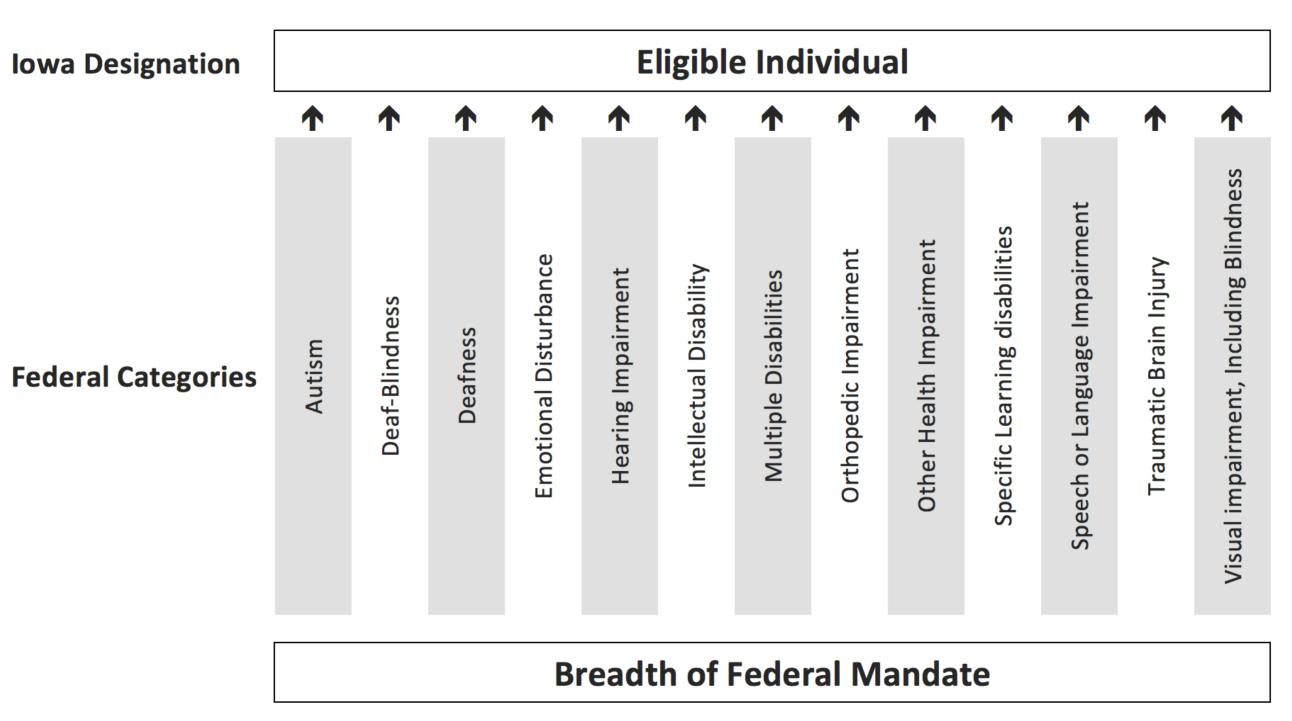DEFINING A DISABILITY
Let us know about your experience on our site. Use the link below to submit your thoughts.
Designation Process for Individuals
The State of Iowa, as permitted by federal law, utilizes a noncategorical designation for all individuals, birth through age 21. The term “Eligible Individual” is used for individuals who are determined to be an individual with a disability and who are in need of special education and related services.

Find additional information on Iowa’s Position on Disability Categories here.
Iowa Performance Domains
In Iowa, the assessment areas for the comprehensive evaluation can be summarized within eight performance domains that represent the areas of skills and functions that are inherent in the 13 federally designated disability categories. These domains assure that all children who have disabilities are identified and provide a framework for consideration of the child’s need for special education.
Academic
Grade level achievement of standards related to basic reading skills (e.g., early literacy, phonics, phonemic awareness, concepts of print, decoding, fluency), reading comprehension (e.g., vocabulary, comprehension, sequencing), basic math skills (e.g., early math readiness, math calculations, numeracy, number sense), applied math skills (e.g., mathematical problem solving, time, money), written expression, listening comprehension, and oral expression.
Adaptive Behavior
Everyday living skills (e.g., dressing, eating, toileting), work skills, or school functioning skills (e.g., meeting timelines, organization of materials, engagement and persistence) that a child learns in the process of adapting to his or her surroundings.
Social Emotional Behavior
Awareness of self, identification, and expression of emotions, self-regulation, and interaction with others.
Communication
Receptive and expressive language (understanding, form, content, or use). This includes, but is not limited to, language (social communication), vocabulary, speech sound production, voice (nasality), or fluency.
Health
The general condition of the body or mind, especially in terms of the presence or absence of illness, injury, or impairments.
Hearing
The ability to perceive sound.
Vision
The ability to see.
Physical
Gross/large motor skills, fine/small motor skills, and mobility for learning, living, and work.
Other Disability Definitions
There are many laws providing protections (e.g., civil rights) and services (e.g., public benefits, tax credits) to persons with disabilities. These laws do not have the same definitions of disability as required by IDEA for special education eligibility.
A child may be determined to have a disability by another agency (Iowa Department of Health and Human Services (HHS), Social Security, etc.), or be diagnosed by a physician, clinic, or health provider with a disability. Such diagnosis or determinations may satisfy the “condition” component of suspicion of an educational disability, however, by itself, it does not establish eligibility for special education.
Despite being a non-categorical state, Iowa Code outlines additional documentation expectations, should a team conduct an evaluation for a Specific Learning Disability (SLD). Iowa’s evaluation methods meet the definition of a full and comprehensive evaluation to identify disability and needs, regardless of assigning a disability category such as SLD.
In the rare cases when an evaluation team is considering an SLD diagnosis, there are some additional considerations and documentation requirements that are included with the final evaluation report. These considerations are outlined in the procedural “steps” of the i3 site.
Explore Step 1 in the Child Find Process
The Child Find process begins with the suspicion of a disability.